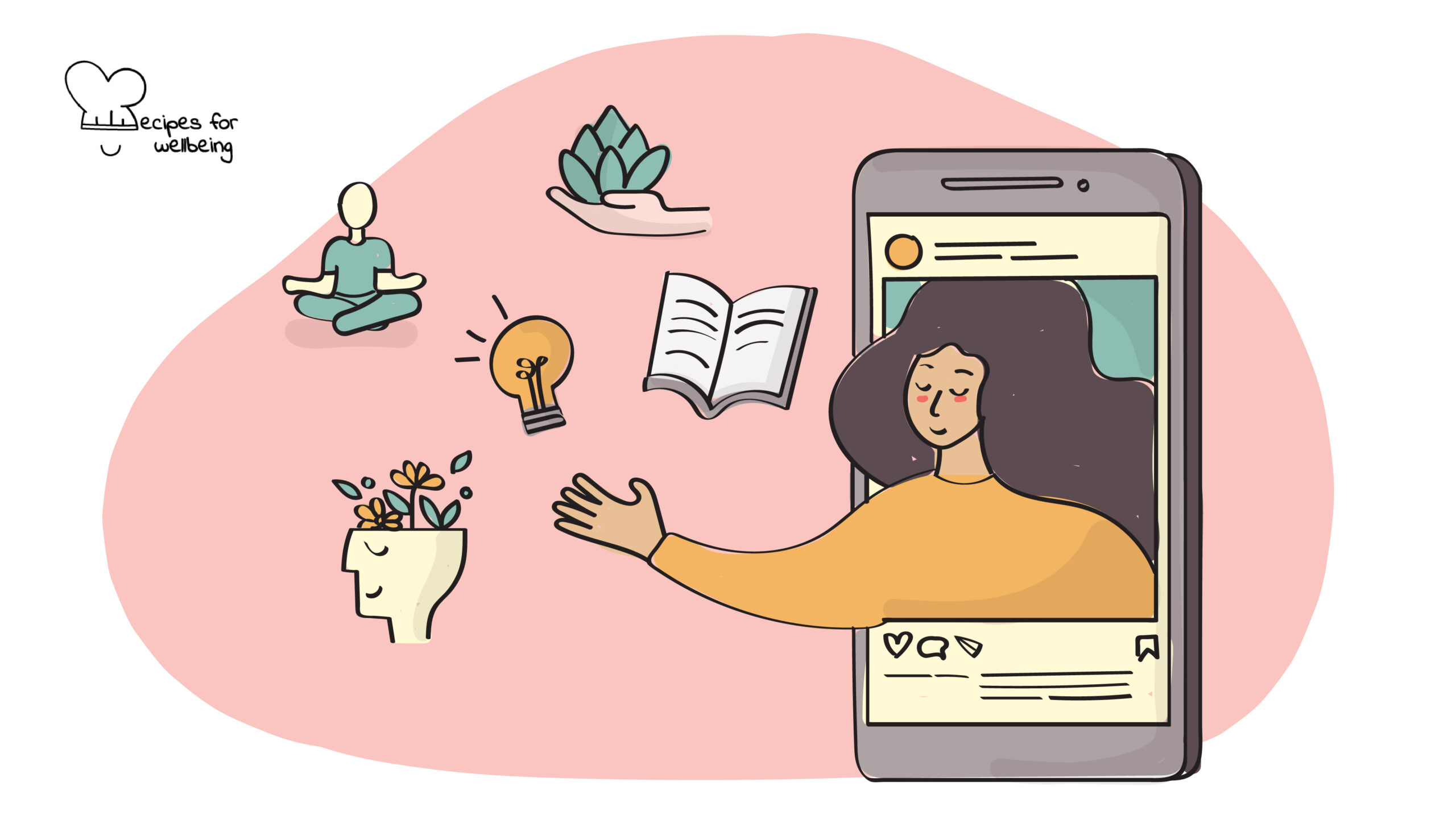
Social media for mental health education
Being able to be your true self is one of the strongest components of good mental health. ―Lauren Fogel Mersy, n.d.
👥 Serves: 1 person
🎚 Difficulty: Medium
⏳ Total time: Ongoing
🥣 Ingredients: Your devices, social media platforms
🤓 Wholebeing Domains: Awareness, Digital Consciousness
💪 Wholebeing Skills: Digital agency, Digital discernment, Digital relating, Mindfulness, Self-awareness

Social media for mental health education
📝 Description
Tips on social media for mental health educators and advocates.
The following recipe shares some valuable guidelines and tips for mental health educators and advocates wishing to amplify the impact of their work through social media.
Social media has become an integral part of modern life. It has challenged the way we communicate, network, and exchange information. With over 3 billion social media users worldwide, it has tremendous potential as a tool for raising awareness and educating people about mental health issues. If used consciously, intentionally, and carefully, social media platforms can provide access to credible information and valuable resources, as well as reduce the stigma surrounding mental ill-health.
This recipe has been kindly donated by Ronie Salazar of VEED.
👣 Steps
Step 1 – Understand your audience
To effectively engage your audience and create content that makes a positive impact, you need to understand their mental health needs, concerns, and preferences. This entails going beyond basic demographics and investing effort into gathering relevant information. This allows you to communicate in a way that resonates with their unique experiences and perspectives.
1.1 Identify common mental health concerns among your audience
- Engage with your audience through comments, direct messages, and community forums to learn about their mental challenges.
- Pay attention to recurring themes or topics related to mental health issues such as anxiety, depression, stress, self-esteem, relationships, and coping mechanisms.
- Collaborate with other mental health professionals or organisations to gain additional insights into prevalent mental health concerns within your target demographic.
1.2 Analyse existing content to understand what resonates with your audience
- Review past social media posts, blog articles, videos, and other content to identify which topics or formats generated the most engagement.
- Take note of comments, likes, shares, and other interactions to gauge audience sentiment and preferences.
- Look for patterns in successful content to inform your future content strategy.
Step 2 – Choose the right platforms
Selecting the appropriate social media platforms is essential for effectively reaching and engaging your target audience. Each platform has unique features, audience demographics, and content formats, so choose wisely based on your specific goals and audience preferences.
2.1 Overview of popular social media platform for mental health education
- Instagram: Known for its visual storytelling capabilities, Instagram can be used to share inspirational quotes, personal stories, and mental health tips through images and short videos. Instagram Stories is a feature that allows users to create interactive content and share longer-form videos with their audience.
- YouTube: As the largest video-sharing platform, YouTube can be used to share in-depth educational content, including tutorials, interviews, and vlogs on mental health topics. Subscribers can engage through comments and discussions, fostering a sense of community.
- X: With its fast-paced nature and character limit, X can be used to share quick tips, resources, and thought-provoking insights on mental health. Hashtags can help users to find the right content for them.
- TikTok: Known for its short-form video content, TikTok can be used to share engaging and entertaining videos on mental health, such as personal stories, coping strategies, and self-care tips.
- Facebook: Despite its declining popularity among younger demographics, Facebook remains a valuable platform for reaching older audiences interested in mental health education. You can harness the power of groups and pages to share thought-provoking articles, host engaging live sessions, and foster fruitful discussions.
2.2 Select platforms based on your target audience demographics
- Consider the age, gender, location, interests, and online behaviour of your target audience when choosing the right social media platforms.
- Refer to your research to identify the most popular platforms among your target demographic and align with their preferences.
- Prioritise platforms where your audience is most active and engaged to optimise the impact of your mental health education efforts.
Step 3 – Create engaging content
By developing compelling visuals, crafting engaging messaging, and incorporating storytelling techniques, you can create meaningful content that captures your audience’s attention and keeps them engaged.
3.1 Develop compelling visuals and messaging
- Use high-quality images, graphics, and videos to effectively convey key messages (make sure to respect copyright laws).
- Incorporate visually appealing design elements, such as colour schemes, typography, and layout, to enhance your content’s overall look and feel.
- Experiment with different types of visuals, including photos, illustrations, infographics, and animations to diversify your content.
3.2 Incorporate storytelling techniques to make content relatable
- Share personal anecdotes, testimonials, or case studies to humanise mental health issues and make them more relatable to your audience.
- Use narrative storytelling techniques, such as character development, conflict resolution, and emotional arcs, to create compelling narratives around mental health topics.
- Encourage audience participation by inviting them to share their stories, experiences, and perspectives on mental health.
- Highlight real-life examples and success stories to inspire hope, resilience, and positive change among your audience.
3.3 Interview mental health experts and other content creators
- Collaborate with mental health professionals, psychologists, counsellors, etc. to provide expert insights, advice, and perspectives on mental health topics.
- Conduct interviews with individuals who have lived experience with mental health challenges or advocates who are passionate about raising awareness and reducing stigma.
- Showcase diverse voices and perspectives by featuring guest interviews with fellow content creators specialising in mental health education or related topics.
3.4 Use video editing tools
- Screen recording: This can be used during live conversations because it allows users to capture and preserve the valuable insights from the discussions.
- Video compressor: This helps optimise file sizes, ensuring videos can be easily uploaded and shared on various platforms. Compressing videos allows quicker uploads and smoother playback, making them more accessible to a broader audience.
- Video translator: This can help disseminate your information to a global audience.
3.5 Use trigger warnings
- Include trigger warnings for sensitive content to help those affected by specific topics.
Step 4 – Provide accurate information
It is important to ensure the content you share is accurate, credible, and trustworthy.
4.1 Cite credible sources
- Make sure to reference reputable sources such as scientific journals, academic institutions, and mental health organisations.
- Include links or citations so your audience can verify the accuracy of the information presented.
4.2 Fact-check content
- Verify the accuracy of information through cross referencing with multiple reliable sources.
- Avoid spreading misinformation or myths about mental health issues.
4.3 Avoid stigmatising language
- Use language that is respectful, inclusive, and non-stigmatising when discussing mental health issues.
- Avoid perpetuating stereotypes of misconceptions that may contribute to stigma or discrimination against individuals with mental health conditions.
- Check out the “Words matter” recipe for additional guidelines on language.
Step 5 – Foster engagement and community
Building an engaged and supportive community around mental health on social media requires active participation and thoughtful moderation.
5.1 Encourage interaction
- Prompt your audience to share their thoughts, experiences, and questions about mental health topics.
- Foster dialogue by asking open-ended questions, conducting polls, or initiating discussions on relevant issues.
5.2 Respond promptly and empathetically
- Acknowledge and respond promptly to your audience’s comments and inquiries.
- Show empathy and understanding in your response, supporting and validating those who meaningfully engage with your content.
5.3 Create safer spaces
- Establish clear guidelines for respectful and constructive communication within your community.
- Moderate discussions to ensure your members feel safe, heard, and valued. If the safety of the space is breached, address it promptly; do not let it drag on.
- Provide resources and referrals to professional support services for those needing additional assistance or guidance.
Step 6 – Promote self-care and boundary-setting
It is also helpful to encourage the development of healthy habits and boundaries to maintain wellbeing whilst using social media.
6.1 Set time limits
- Limit the time spent on social media to prevent burnout and maintain balance. Check out the recipe “11 ways to improve digital boundaries” for additional guidelines on setting boundaries.
6.2 Prioritise mental health
- Make self-care a priority by engaging in activities that promote relaxation, stress reduction, and emotional wellbeing. Refer to the recipe “Digital goodies” for suggestions for wellbeing apps.
6.3 Model healthy behaviours
- Lead by example and demonstrate healthy habits to your audience, such as taking breaks, practising mindfulness, and seeking support when needed. If you struggle with disconnecting from social media, read the recipe “Take control of your life with a digital detox” for tips.
Step 7 – Evaluate and adjust your strategy
Finally, integrate regular feedback loops to assess the impact of your efforts and refine your approach accordingly.
7.1 Monitor KPIs
- Track key performance indicators (KPIs) such as engagement rates, reach, and audience demographics to gauge the effectiveness of your content.
7.2 Solicit feedback
- Actively seek input from your audience through surveys, polls, and direct messages to understand their preferences and needs.
7.3 Iterate and refine
- Use the insights gained from your KPIs and audience feedback to iterate on your content strategy, experimenting with different formats, topics, and messaging.

